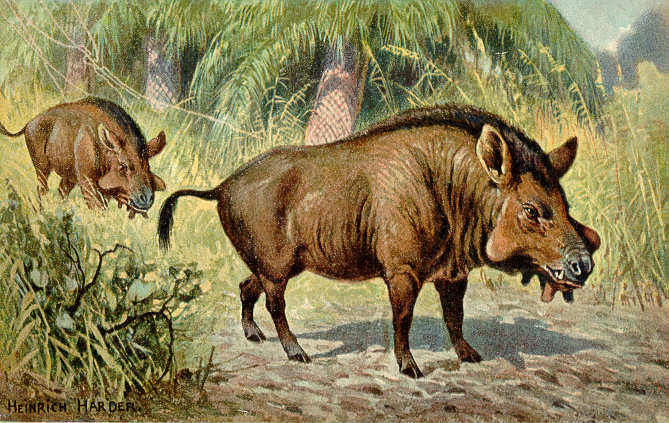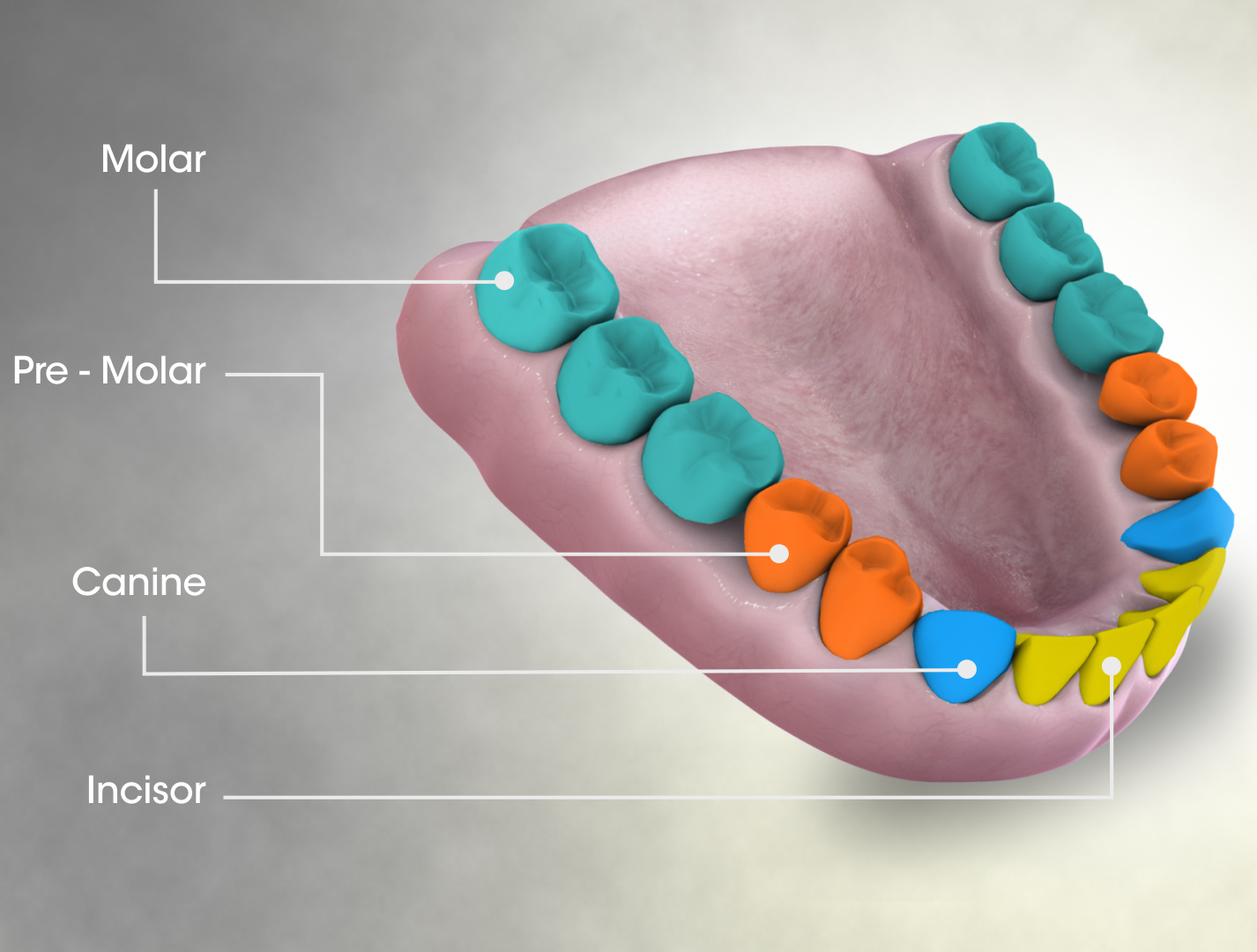|
Helohyidae
Helohyidae were a group of artiodactyl mammals. They were most prominent in the mid-to-upper Eocene (~50 to 39 million years ago). Description Helohyidae share vague similarities to present-day pigs, though were slimmer in build. They possessed prominent canines and molars with bunodont cusps, bulging dental wreaths, and wrinkled enamel. Their upper molars were usually squared, due to the enlargement and displacement of the metaconule, but there was also a small hypocone and hypoconule. The paraconule was reduced and there was no mesostyle. Their lower molars increased in size as they proceeded to the bottom of the jaw, and the paraconid was small or absent. Some forms (e.g. ''Gobiohyus'') possessed small diastemas that separated the premolars from each other. The snout was usually elongated (e.g. in ''Helohyus''), but in some forms ascribed to this family ('' Achaenodon''), it was very short. Compared to other primitive artiodactyls such as dichobunids, they possess ... [...More Info...] [...Related Items...] OR: [Wikipedia] [Google] [Baidu] |
Achaenodon
''Achaenodon'' is an extinct artiodactyl mammal, possibly belonging to the eloiids. It lived in the Mid-To-Upper Eocene (about 43-39 million years ago) and its fossil remains have been found in North America. Description This animal was large and looked vaguely like a wild boar, but the size of an American black bear (''Ursus americanus''): it was about two meters long and weighed about 285 kilograms. Achaenodon's snout was very short and sturdy, with large sideways expanded zygomatic arches, making the skull extremely wide. There was a very high sagittal crest, which connected later to an expanded nuchal crest; these two structures, together with the large cheekbone arches, indicate that the musculature of the jaws was extremely powerful. ''Achaenodon''s teeth were characterized by large curved canines and large post-dumping teeth with a bunodont structure. The dental formula was typical of the artiodactyls with three incisors, a canine, four premolars and three molars; th ... [...More Info...] [...Related Items...] OR: [Wikipedia] [Google] [Baidu] |
Dichobunidae
Dichobunidae is an extinct family of basal artiodactyl mammals from the early Eocene to late Oligocene of North America, Europe, and Asia. The Dichobunidae include some of the earliest known artiodactyls, such as '' Diacodexis''. Description They were small animals, averaging about the size of a modern rabbit, had many primitive features. In life, they would have resembled a long-tailed muntjac or chevrotain. Dichobunids had four or five toes on each foot, with each toe ending in a small hoof. They had complete sets of teeth, unlike most later artiodactyls, with their more specialist dentitions. The shape of the teeth suggests they were browsers, feeding on small leaves, perhaps in the forest undergrowth. The shape of their bodies and limbs suggests they would have been fast-running animals, unlike most of their contemporaries. Taxonomy Classification of dichobunids following McKenna and Bell: *† A dagger, obelisk, or obelus is a typographical mark that usually in ... [...More Info...] [...Related Items...] OR: [Wikipedia] [Google] [Baidu] |
Artiodactyl
The even-toed ungulates (Artiodactyla , ) are ungulates—hoofed animals—which bear weight equally on two (an even number) of their five toes: the third and fourth. The other three toes are either present, absent, vestigial, or pointing posteriorly. By contrast, odd-toed ungulates bear weight on an odd number of the five toes. Another difference between the two is that many other even-toed ungulates (with the exception of Suina) digest plant cellulose in one or more stomach chambers rather than in their intestine as the odd-toed ungulates do. Cetaceans (whales, dolphins, and porpoises) evolved from even-toed ungulates, and are therefore often classified under the same taxonomic branch because a species cannot outgrow its evolutionary ancestry; some modern taxonomists combine the two under the name Cetartiodactyla , while others opt to include cetaceans in the already-existing Artiodactyla. The roughly 270 land-based even-toed ungulate species include pigs, peccaries, hippop ... [...More Info...] [...Related Items...] OR: [Wikipedia] [Google] [Baidu] |
Hypocone
A cusp is a pointed, projecting, or elevated feature. In animals, it is usually used to refer to raised points on the crowns of teeth. The concept is also used with regard to the leaflets of the four heart valves. The mitral valve, which has two cusps, is also known as the bicuspid valve, and the tricuspid valve has three cusps. In humans A cusp is an occlusal or incisal eminence on a tooth. Canine teeth, otherwise known as cuspids, each possess a single cusp, while premolars, otherwise known as bicuspids, possess two each. Molars normally possess either four or five cusps. In certain populations the maxillary molars, especially first molars, will possess a fifth cusp situated on the mesiolingual cusp known as the Cusp of Carabelli. Buccal Cusp- One other variation of the upper first premolar is the 'Uto-Aztecan' upper premolar. It is a bulge on the buccal cusp that is only found in Native American Indians, with highest frequencies of occurrence in Arizona. The name is not ... [...More Info...] [...Related Items...] OR: [Wikipedia] [Google] [Baidu] |
Anthracotheres
Anthracotheriidae is a paraphyletic family of extinct, hippopotamus-like artiodactyl ungulates related to hippopotamuses and whales. The oldest genus, '' Elomeryx'', first appeared during the middle Eocene in Asia. They thrived in Africa and Eurasia, with a few species ultimately entering North America during the Oligocene. They died out in Europe and Africa during the Miocene, possibly due to a combination of climatic changes and competition with other artiodactyls, including pigs and true hippopotamuses. The youngest genus, ''Merycopotamus'', died out in Asia during the late Pliocene. The family is named after the first genus discovered, '' Anthracotherium'', which means "coal beast", as the first fossils of it were found in Paleogene-aged coal beds in France. Fossil remains of the anthracothere genus were discovered by the Harvard University and Geological Survey of Pakistan joint research project (Y-GSP) in the well-dated middle and late Miocene deposits of the Pothohar Plateau ... [...More Info...] [...Related Items...] OR: [Wikipedia] [Google] [Baidu] |
Peccary
A peccary (also javelina or skunk pig) is a medium-sized, pig-like hoofed mammal of the family Tayassuidae (New World pigs). They are found throughout Central and South America, Trinidad in the Caribbean, and in the southwestern area of North America. They usually measure between in length, and a full-grown adult usually weighs about . They represent the closest relatives of the family Suidae, which contains pigs and relatives. Together Tayassuidae and Suidae are grouped in the Suina within the Artiodactyla (even toed ungulates). Peccaries are social creatures that live in herds. They eat roots, grubs, and a variety of foods. They can identify each other by their strong odors. A group of peccaries that travel and live together is called a "squadron". A squadron of peccaries averages between six and nine members. Peccaries first appeared in North America during the Miocene, and migrated into South America during the Pliocene-Pleistocene as part of the Great American In ... [...More Info...] [...Related Items...] OR: [Wikipedia] [Google] [Baidu] |
Diastema
A diastema (plural diastemata, from Greek διάστημα, space) is a space or gap between two teeth. Many species of mammals have diastemata as a normal feature, most commonly between the incisors and molars. More colloquially, the condition may be referred to as gap teeth or tooth gap. In humans, the term is most commonly applied to an open space between the upper incisors (front teeth). It happens when there is an unequal relationship between the size of the teeth and the jaw. Diastemata are common for children and can exist in adult teeth as well. In humans Causes 1. Oversized Labial Frenulum: Diastema is sometimes caused or exacerbated by the action of a labial frenulum (the tissue connecting the lip to the gum), causing high mucosal attachment and less attached keratinized tissue. This is more prone to recession or by tongue thrusting, which can push the teeth apart. 2. Periodontal Disease: Periodontal disease, also known as gum disease, can result in bone loss th ... [...More Info...] [...Related Items...] OR: [Wikipedia] [Google] [Baidu] |
Molar (tooth)
The molars or molar teeth are large, flat teeth A tooth ( : teeth) is a hard, calcified structure found in the jaws (or mouths) of many vertebrates and used to break down food. Some animals, particularly carnivores and omnivores, also use teeth to help with capturing or wounding prey, te ... at the back of the mouth. They are more developed in mammal, mammals. They are used primarily to comminution, grind food during mastication, chewing. The name ''molar'' derives from Latin, ''molaris dens'', meaning "millstone tooth", from ''mola'', millstone and ''dens'', tooth. Molars show a great deal of diversity in size and shape across mammal groups. The third molar of humans is sometimes vestigial. Human anatomy In humans, the molar teeth have either four or five cusp (dentistry), cusps. Adult humans have 12 molars, in four groups of three at the back of the mouth. The third, rearmost molar in each group is called a Third molar, wisdom tooth. It is the last tooth to appear, ... [...More Info...] [...Related Items...] OR: [Wikipedia] [Google] [Baidu] |



